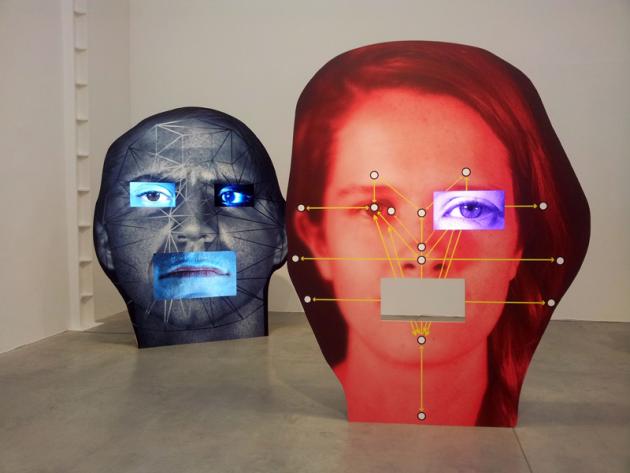The Lisson Gallery presents the exhibition Tony Oursler – template/variant/friend/stranger, a solo exhibition, and the artist’s first of new work in the UK for over five years. The show centres around the artist’s fascination with the evolution of identity via the security techniques of facial recognition. Oursler explores the nuanced ramifications of these tools increasing ubiquity in daily life. A series of seven imposing photographic faces loom over the spectator in the main gallery, all but one punctured by video screens of eyes or mouths. One of part of this installation is an endlessly shifting projection of 150 algorithmically produced Eigen faces. Each of these giant portrait heads bears the network of marks or nodes associated with different facial recognition systems, used by border controls, law enforcement agencies and even ATM machines.
Oursler’s work revolves around an exploration of human identity – and the artist is known as a pioneer of video art and installation; here Oursler marries the sculptural object with video art to create his latest oeuvre of work. Multimedia works reflecting the complicated nature of contemporary identity. The sculptural collection in the main gallery are nearly nine feet tall, the seven portraits recall the captures intended for photo identification cards, and other disturbing trends in security technology.
Oursler reminds the viewer – having just left the bustle of Bell Street in north west London to enter the quiet of Lisson’s space, only punctuated by the artist’s talking heads – that they are living in one of the world’s largest systems of surveillance. Only this was humorously juxtaposed by an empty chair in the space, where a gallery invigilator ‘should’ have been keeping a beady eye on me, preventing me from taking photographs (oh the irony). Comically – even this unintentional absence, and the technology of gallery surveillance cameras just serve to highlight Oursler’s point. In this instance the gallery is no longer a white cube space, as the cameras become glaringly obvious in juxtaposition to the nature of the works.

Overlaying the artist’s giant emotionless faces are markings reflecting the networks of nodes on specific features that facial recognition systems use to recognise and differentiate between individuals, transforming the standard portraits into electronic profiles. The surface are punctuated by video screens of eyes or mouths, animating the cut-outs and forming a dialogue between them – and a relationship the the viewer – as the artist creates a collection of faces that end up watching you, introducing their blinking eyes, and the unsettling feeling of being spied upon.
The works highlight the utterly inhuman nature of biometric analysis, the artist highlights the ways in which we have distorted and subverted our own identities through contemporary technology, sifting us and categorising us in terms of visual recognition, physical body traits, storing our genetic fingerprints, and following us with GPS via our mobiles, the world has never been more invasive and yet utterly impersonal. Oursler’s faces should have been cattle, or sheep.
The images, are staggered in a maze-like layout throughout the space in the manner of theatrical props. As if giant police mug shots or closed-circuit camera stills, the original identity of the individuals is distorted and impersonalised by their mediation through technology. The works also highlight the antithetical principle of the phenomena of physiognomy, anthropometry and pareidolia, where patterns in images or objects triggers the recognition of a face by the brain where no face exists. A subject that the artist has written about, and highlights the evolution of our brains to seek out resemblances of ourselves for the purpose of communication and survival.

The artist highlights this concept with works in the second space, with nine aluminium panels that hang on the walls like an array of masks, many barely recognisable as faces, etched on bare, reflective surfaces, employing mirrors embedded with similar facial video, but now reflecting and incorporating the image of the viewer as they study the work.
All the while the gallery is filled with whispers and murmurs, as the artist giant talking heads espouse the power of technology in terms of both its potential and its dangers, conveyed in their fears in whispers, creating an effect of people talking to themselves, or attempting to break through the technology that their true identity is locked behind – in an attempt to talk to each other.
The faces at once signify and attempt to break with their technological subversion. Oursler’s body of work serves creates a dialogue where traditional social structures and definitions of identity are mediated by technology, the effect of which is dangerously dehumanising, and impersonal, where Prosopagnosia, or face blindness, may become an illness of the state, where we will only recognise ourselves through the secondary or tertiary filter of technology.

The smearing of paint on Oursler’s video mouths and eyes is at once a reference to the theatricality of the works, and individual’s attempts to render themselves unreadable to the system. The artist’s own systems are, as always highly engaging works as powerful in presence as they are disturbing in subject matter.
Oursler’s return to exhibiting in the capital is a welcome sight, as the works are a scathing condemnation of our narcissistic and surveillance infested culture. The artist’s works present individuals stripped of personality and subjective identity, they are in fact reduced portraits, homogenised, the ultimate objectification – they are reflections of our own disturbing invention.
Tony Oursler: template/variant/friend/stranger – Lisson Gallery 27 Bell Street – until 7 March 2015
Words: Paul Black Photos: P A Black © Artlyst 2015 all rights reserved

